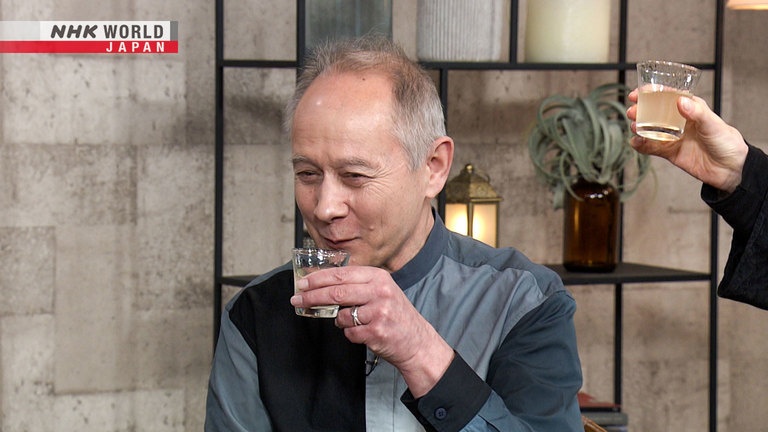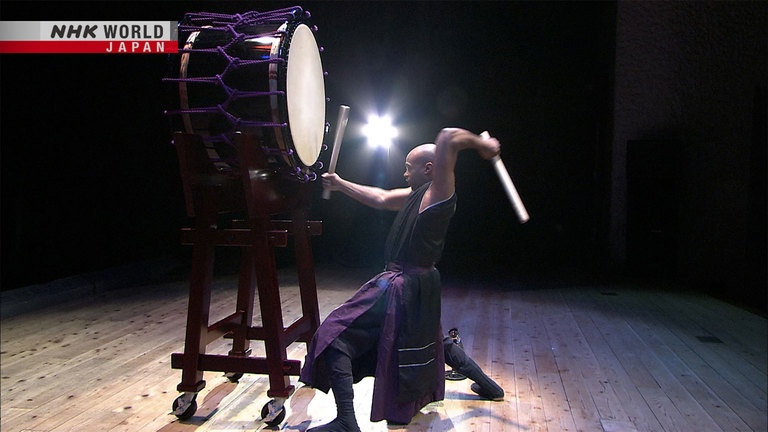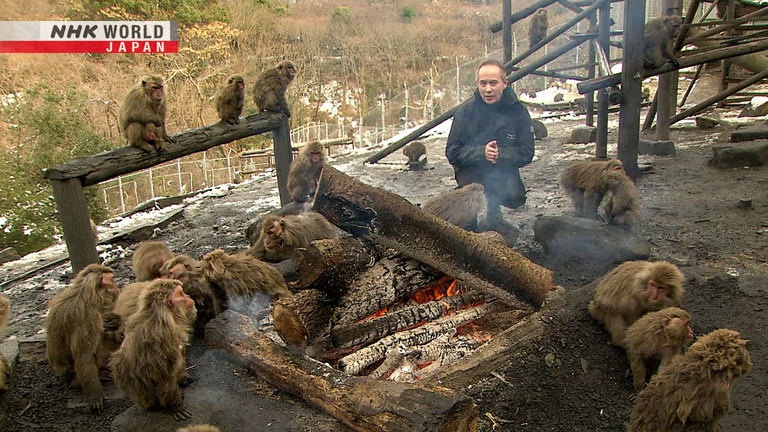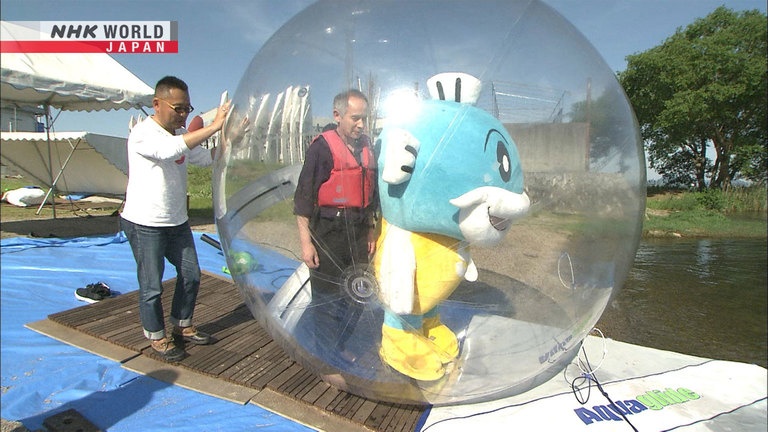20th Anniversary Special Part 1
*First broadcast on March 21, 2024.
It's a 20th anniversary special! Presenters and viewers join Peter Barakan to look at some highlights. Part one features musician and Japanology fan Todd Rundgren, sake tasting and taiko drumming.




Transcript
Hello. I'm Peter Barakan.
My program, Japanology Plus,
is celebrating its 10th anniversary
and it's been 20 years now
since the birth of the original
Weekend Japanology in 2003.
Over the space of two programs,
we're going to look back
at some of the many episodes
that we broadcast during that time.
Japanology Plus
Japanology 20th Anniversary Special
Part 1
So, over the last 20 years or so,
we've broadcast so many
episodes of Japanology...
far more than my increasingly
feeble memory can retain anymore.
But we are going to go back and
look at a few of those episodes.
There are some that I myself
would like to see again.
We've also asked viewers
to submit their requests online.
And I'm not alone here
in the studio today.
I'm accompanied by,
first of all, Emma Howard,
whose dulcet tones you will
have heard many, many times,
but you're probably seeing
for the first time on camera.
Emma, nice to have you here
in the studio with us.
Nice to be here.
And also, Matt Alt, who is our original
presenter for the Plus One segment.
Always a pleasure.
Nice to have you here, too.
And Kyle Card, who is our
current presenter for Plus One.
Hello, everyone. Great to be here and
great to finally meet everyone in person.
And we're also going to have
some guests on the program.
And starting off with...
live from Hawaii, Todd Rundgren.
Konnichiwa!
Todd Rundgren is a musician
and record producer from the US.
He's a big fan of Japan and
a regular Japanology Plus viewer.
He's joining us as a guest for
our 20th anniversary special.
Now, I've been listening to your
music for over 50 years now,
so I'm well aware of you, of course.
I'm sure many people
are going to be wondering
what you're doing on Japanology.
I think it was 2019.
You were here doing some gigs,
and a lady from your fan
club introduced me to you.
And as soon as you saw my face,
you said, “I know you.”
And I'm going, “What? Why?”
We uh, we watch NHK World.
Actually, I watch anything that's,
that's about Japanese culture.
It's something that I've had a long
and fruitful interest
in ever since the late '80s.
I've probably been to Japan
at least once a year on average.
And I'm just so fascinated
with the culture.
Okay, great.
We'll ask you about your thoughts on
some of the videos we'll
be showing in a few minutes.
Sure thing.
Okay, thank you.
So let me introduce
our next pair of guests,
who are appearing from Singapore.
Mr. Khu, and Sakai Namiko-san.
Hello.
Hi.
Hi. Nice to see you.
Khu and Sakai are a married
couple living in Singapore.
They created a taiko drumming group
and are helping spread Japanese
culture throughout Asia.
So, are you regular viewers of Japanology?
Yes.
I like this program very much
because it's kind of
a teaching material for me
to know more about my wife's country.
So, we're very happy to join you today.
Well, please stay around
and watch the videos
and we will ask you
for your comments later on.
So, let's go on to our first group of
excerpts from old episodes of Japanology.
These ones are on the theme of nature.
Animals & Nature
Let's start with an episode about monkeys—
which didn't seem to mind
Peter's company at all.
Today I've come
to the Japan Monkey Center,
which is in Inuyama,
up in the mountains outside Nagoya.
Where I come from in England, they
don't have any wild monkeys, of course.
I did know that Japan had monkeys,
but in all the years I've been here,
this is my first face-to-face
encounter with these guys.
Japan is known for a winter
sight involving monkeys.
Monkeys that take hot spring baths.
Lucky bleeders.
Some zoos provide hot
springs for their monkeys,
Spiky hair.
and there are hot springs especially
for wild monkeys to enjoy.
At this Monkey Center, there are
even monkeys that enjoy bonfires.
Oh, wow.
Generally, animals are afraid of fire,
but these monkeys gather
round the bonfire to keep warm.
Peter: Cause it's cold enough to...
This monkey got so warm,
it nodded off and is fast asleep.
Kyle: That's the stuff.
This next episode showed
the beauty of Japan's snow.
The Japanese have even
incorporated special features
for enjoying snowscapes into architecture.
Opening the lower panels of these paper
screens offers a view of a snowy garden.
They're called snow-viewing screens.
The framed view further enhances
the beauty of the garden in winter.
And Japanese gardens themselves
have features devised with snow in mind.
These snow lines are ropes strung
from a pole to branches,
preventing them from snapping
under the weight of snow.
The tent-like forms make for
truly unique, wintry garden scenery.
No traditional Japanese garden
is complete without a stone lantern.
The flame burning within casts
a reddish glow on the snow.
This kind of effect
is a typically Japanese way
to enjoy and share the beauty of snow.
Next, Lake Biwa: Japan's largest lake.
Its many beaches are great places
to enjoy water sports and activities.
Peter ended up trying something new.
And perhaps the most eye-catching
thing we have is our waterball.
Waterball?
Matt: Oh, you did that?
You get inside,
sit down or lie down, and you look
at the water as a canoe pulls you along.
You know, roll in it.
Would you like to give it a try,
Mr. Barakan?
You get to walk in it.
It's a little lonely in there on your own,
so we've brought a friend:
Caffy, Lake Biwa's mascot.
He gets his name and look
from the famous Lake Biwa catfish.
Matt: Excellent.
Peter: With a Mohican hairstyle too.
Matt: Did you give him a hug?
Here we go.
Oh, you got in there with it?
Oh, man. Wow.
Well, we'll start off slow.
Emma: You can cuddle him!
Kyle: This is good TV.
Have fun!
We're going backwards.
Good episode.
Oh, you and that mascot.
Hey Caffy, just take care.
I'm a bit lost for words here.
Todd, has your respect
for Peter gone up or down
after seeing him in the waterball
with the mascot?
Oh, way up.
The one with the monkeys,
there was a scene where we all
ate sweet potatoes together.
Matt: Oh, with the monkeys?
Peter: Yeah.
Matt: Wow.
And that was what had really...
was etched into my mind.
They'll probably remember you
when you go back now.
So, did you jump into the onsen
with them too?
I'll leave that to your imagination.
There's too many great moments
for a little digest like this.
Yeah, really.
Todd, were there any bits out of
those that rang a bell with you?
Well, unfortunately,
I have not dined with monkeys yet.
But you know, it's in my bucket
list somewhere, you know?
Yeah, when I visit Japan,
I usually don't get up north that much.
I regret it, actually.
You know, there's...
it's a whole different thing up there.
And also, Ainu culture is something
that's fascinating to me as well.
You know, the primeval roots
of Japanese culture,
and how they are connected
in some ways to...
to other northern...like northern Russia
and places like that, you know,
where the cultures start to blend
together a little bit as well.
Right.
It's one of my regrets.
I'll get there eventually.
I feel a road trip in our future.
We should all road trip up north together.
Sign me up.
Okay. And Khu-san
and Sakai-san in Singapore.
Any thoughts on those videos?
Yes, I pretty much like the episode
of the monkeys in the snow place.
Because the place where we live is
actually quite near to the nature reserve.
Lots of monkeys are running around.
But in Singapore, no snow.
So, these two things strike me the most.
Right.
Okay. Thank you.
So, let's move on
to the next group of videos.
And this time it's art and culture.
Art & Culture
On this episode of Weekend Japanology,
Peter met Kaori Nara Turner,
a makeup artist who worked
in Hollywood for 30 years.
Wow, this is from
the very very early days.
Wow.
My fun time.
Okay.
Oh, no!
It looks like you're...you're actually
sticking a knife into Peter's cheek.
Matt: Oh, wonderful.
Kyle: She is, in a way.
Oh, here comes the blood.
Oh, wonderful.
Were you all studio-based back then?
First few years. First three, four years.
Usually I use blood,
but I don't do that because...
You don't want to make my shirt all red.
I should have worn a red shirt today.
That's all.
Okay, so how do I look?
It's incredible.
Matt: It's like Night of the Living Dead.
Kyle: Oh, wow. That's grotesque.
In an episode about armor,
we saw what Peter would look like
as a military commander.
Japanese armor was expertly crafted
to save the wearers from attacks
using arrows or swords.
Suits were made featuring diverse
motifs inspired by animals,
the natural world, and religion.
Matt: Looking good, Peter.
Well, this is the full set.
And it's heavy.
I don't know. I feel like if somebody
just pushed me with one finger,
I'd probably fall over and not
be able to stand up anymore.
But let's just see if I can even walk.
Just about. Boy, this is heavy.
Unbelievable.
In a Japanophiles interview,
we met drummer Art Lee.
A sound that reverberates in your bones.
Drumsticks striking like hammers.
This is Japan's own traditional
style of drum, the taiko.
And Art Lee, an American,
is a master of the taiko.
In 2005, Lee was the first foreign drummer
to be awarded the highest prize
at the prestigious
Tokyo International Taiko Contest.
So, we have here the three
different styles of drums
that you use in your set-up.
Yes, actually, there are lots of
other types of different styles,
but these are the three basic styles
that you'll find in most taiko groups.
OK.
This drum here, this is the odaiko.
Yeah, “big drum.”
“Big drum,” yes.
It actually has many different
sounds across the face of it.
Just to show you a little bit
of what that sounds like,
I'll use a small bachi here.
If you play the middle,
It's usually quite low.
If you play the side,
It's usually quite higher.
So you can go through and it has
about seven different sounds.
- That many?
- Yes.
OK, that's quite a lot. But I guess
that's because it's such a big drum, too.
Right, right.
Alright.
Wow, the first one of those four,
going all the way back to the very,
very first incarnation of this program,
Weekend Japanology,
when it was a studio-based program...
had you ever seen any of those before?
Never.
The guest was a makeup artist
for theatricals, of course. Yeah.
The last of those four, with Art Lee,
was just over ten years ago.
I think 11 years ago?
And Art Lee is also joining us.
Hello. Hello.
Hello, Art. Nice to see you.
What have you been doing since?
Oh, well, I've been continuing
with the taiko lifestyle,
but I've also had a lot
of other things going on.
Where are you based?
I'm based in Iida city, Nagano Prefecture,
which is the southernmost
city of Nagano Prefecture.
And I see you've got
a big drum behind you there.
Are you going to play something for us?
Yeah.
Fantastic.
Fantastic!
Thank you, Art. That was great.
Excellent.
So Todd, how was that performance for you?
I love taiko because,
you know, before there were
rock concert drum solos,
there was taiko, you know,
which was not just the drum,
but a whole show that goes with it.
A way of performing.
It's something to look at as well
as something to listen to.
So, I've always enjoyed it.
Right.
Living in Hawaii, I imagine there's
a lot of Japanese people there.
Do you get to hear taiko
close to where you are?
Well, I'm on one
of the more remote islands,
so I'm sure that in Honolulu there must
be a taiko society of some kind.
I just have not had an opportunity
to experience it.
Yes, we do have a very strong Japanese
representation in Hawaiian culture.
It's been that way for a long time.
So it's one of the reasons, I guess,
why I have an affinity for...
not just for the islands,
but for Japanese culture,
because I get to experience it maybe
more than people on the mainland do.
Right.
Okay. Well, thank you so much for taking
time out of your day to be with us today.
And I'll look forward to seeing
your gig next time you're here.
Which...do you have any specific
plans at the moment?
Well, I was just there
in November with Daryl Hall.
We did three shows.
And possibly, by the end of this year,
I may get back there.
So I'm...got my fingers crossed.
Okay. Well, thanks again.
Thank you very much for being with us.
Thank you so much.
Kyle: Thanks Todd.
Emma: Thank you.
Todd: Bye bye.
Matt: Thanks for coming.
And Khu-san and Sakai-san in Singapore.
Are you there?
Yes.
You are taiko players too.
So did you enjoy that performance by Art?
Of course.
He is a big senpai to me.
And the way he plays is very dynamic.
And actually,
I went to Narita Taiko Festival
and watched his performance live.
So today, very happy
to see you again, Art-san.
Nice to see you too.
Okay, great.
Thank you so much for joining
us on the program today,
and I hope we get to see you again...
hear you again soon.
Thank you.
And congratulations on your 20th.
It's our 20th too,
so we're kind of celebrating together.
Oh, congratulations.
Alright. Thank you.
Thank you.
And let's go to our next group of videos.
And this time, it's on daily life.
Life & Lifestyle
In an episode about the power of design,
we met the internationally
renowned architect Ban Shigeru.
He makes innovative use
of paper and cardboard,
drawing attention to their potential
as building materials.
After the 1999 earthquake in Turkey,
Ban built emergency housing.
Beer crates and sandbags
formed the foundation.
Rows of cardboard tubes were
placed on top to become walls.
Sheets of cardboard
were used on the inside.
The homes had a reputation for
being well-insulated and comfortable.
They're easy to assemble and have
since been used around the world.
Here's another clever invention.
Japan is a nation of vending machines.
5.2 million of them!
You find them everywhere,
selling all sorts of products.
For example, take a look at this.
And every one of these is selling
canned and bottled drinks.
It's perhaps an indication of how
little crime there is in Tokyo,
although increasingly these days
you'll find vending machines,
which, in addition to cash,
cater to prepaid cards as well.
Now, these drink machines are
by far the most prominent,
but you'll also find machines
which sell a variety of perhaps slightly
less predictable goods, too.
For example, a vending
machine selling bananas.
A nice healthy snack,
if you had to leave the house at the crack
of dawn without time for breakfast.
Or if you got caught in a sudden downpour,
there are umbrella vending machines.
There are even machines
selling paperback books.
Begin Japanology introduced
the many uniforms worn in Japan.
Uniforms for restaurant workers,
of course,
and those for cleaners and florists...
In Japan, uniforms are worn by
a very broad range of professions.
While many primary schools
have free dress codes,
around 90% of junior high and high
schools require uniforms.
Even in workplaces
that are mainly desk jobs,
many companies issue uniforms to maintain
a sense of professionalism and unity.
This is a Korean-style barbecue
restaurant in Tokyo.
Recently, this T-shirt-style uniform
has been spreading to many restaurants.
What's on the back?
That's the restaurant's slogan,
trumpeting that it's only 1,500 yen per
person for all-you-can-eat-and-drink.
The vending machine.
That was...that was something else.
I mean, I had no idea that,
you know, some of these things
you could buy in machines.
I don't know where they find these things.
Yeah, I've never seen umbrellas.
I've seen bananas.
You've seen bananas?
That was a new one for me.
Yeah, there's one in Shibuya Station.
Oh, well I'm heading there after this.
I need a banana.
Take it back to the monkeys.
Exactly!
So Khu-san, Sakai-san, are you there?
Yeah.
Any others of those videos
that you found interesting?
The uniform.
As you can see,
we also have very proudly...
to have our own uniform in Singapore.
Oh, cool.
Excellent.
Thank you very much
for being with us today.
- Thank you.
- Thank you.
OK, now for our last group of videos,
and this time it's food.
Food & Drink
Begin Japanology drew attention to
how much Japanese people like squid.
This fishing boat's reeling them in!
With an annual catch of 120,000 tonnes,
Japan's the world's biggest eater
of squid and cuttlefish.
Squid is eaten many different ways,
the simplest being sashimi.
Here we have sautéed squid
flavored with soy sauce.
Squid can also be stewed or fried…
it's an essential part
of Japanese cuisine.
So yummy!
And what in the world is that?
This dries the squid,
makes “half-dried squid.”
Oh, so you don't just
hang them out to dry.
You put them on the machine
and it's like a squid-go-round.
They dry faster.
Next, an episode all about soba noodles.
Soba noodles are one of the most
popular foods in Japan.
There are various types of soba noodle,
and they're served in many different ways.
The custom of eating soba
on New Year's Eve—
known as toshikoshi soba—
is considered auspicious and thought
to bring good fortune to all the family.
Because the noodles are long,
the traditional belief is that
they bring a long, healthy life.
Murayama, in Yamagata Prefecture,
lies in the heart of soba country.
A soba festival is held here every year.
The noodles are served
on a tray 60 meters long,
allowing 330 people to eat
from it all at once.
One of the more unusual ways of
eating soba is called wanko-soba—
a tradition in Iwate Prefecture.
The noodles are served in small bowls
that are constantly refilled,
as soon as they're empty.
In competitions,
the contestants gobble up serving
after serving, hardly pausing for breath!
Sake brewer Philip Harper.
We spoke with him in
a Japanophiles interview.
An alcoholic drink brewed from rice and
water, sake is quintessentially Japanese.
But with its rich flavor refined
over centuries by skilled brewers,
it has recently achieved
worldwide popularity.
Sake brewers create that flavor
using traditional techniques
that date back to the 17th century.
The master brewer is in charge of brewing,
and Philip Harper is the only foreign
master sake brewer in the whole of Japan.
Harper has been involved
in sake brewing for 20 years.
His quest is to produce the ultimate sake.
He uses every ounce of his skill
to make the sake he sees
in his mind's eye a reality.
Yeah, the food episodes
can be a lot of fun to do.
Make your tummy rumble.
And Philip Harper,
at the end there with the sake episode,
he was a very nice guy,
and he makes excellent sake.
I think we have some of his here.
Philip, you're here remotely as well.
Nice to see you.
Hi there. Good to see you again.
We've got two glasses of
sake each in front of us.
And you're going to have
to explain what they are,
because they look a bit different
from the normal ones.
Right. And both of the sakes
that you have in front of you
are made completely with just
the yeast living in our brewery.
And the, the one with the darker color,
the one which, as you can see,
has an English name, “Time Machine,”
that is made from a recipe from 1712.
If this was a normal sake and you
wanted to get this much color,
it would take you like
about ten or 15 years.
But because of the really
strange brewing system,
we have about five years' worth
of color on day one
and about a dozen years
of color in just a year or two.
So this is completely different
from contemporary brewing.
But this is very mild.
You already drank it?
What about this one here?
The slightly cloudy-looking one.
This is also made with wild yeast.
But it's closer to the way that sake
was made 100 years ago here,
rather than 300 years ago.
And we brew it for lots of acids
and lots of amino acids.
So it's a really big flavor profile.
Very nice. Very nice.
Oh, that is great!
That is really great.
This is my favorite type, actually.
I love both of these.
And presumably you're creating
new varieties all the time, as well.
Yeah, new things, but I mean,
the new things that we do tend
to be about making the sake older
or brewing with antique brewing methods,
so for us, the new stuff is the old stuff.
Well, it's been great talking to you.
And thank you so much
for sending the sake.
My pleasure. Okay.
Okay.
Here we are at the end of this episode.
Emma, Kyle, Matt, thank you
very much for being with us
and we'll all be back
for the next issue as well,
and another look at some of the episodes
we've presented over the last 20 years.
See you then.
Cheers.